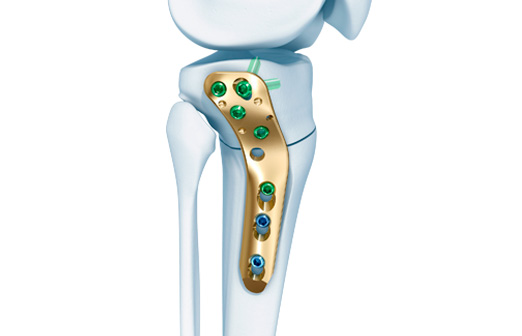Knee osteotomy
- Home
- Treatments
- Knee osteotomy
Knee osteotomy
The knee osteotomy is a surgical technique in which a cut is made either in the tibia (shinbone) or in the femur (thighbone) in order to correct any wrong alignment of the leg. It is used mainly to correct a deformity in the leg axis, either in a bowed leg (varus knee) or in a knock-knee (valgus knee).
There are several reasons that may cause a leg deformity. Sometimes, a constitutional disorder of the bones is present, which starts in the childhood. In other cases it occurs after a fracture of the femur or tibia that heals in a wrong position.
However, most frequently the reason is an early osteoarthritis that affects just one of the compartments of the knee, where the cartilage has disappeared and the articular surfaces of that compartment get closer, and thus provokes a deformity of the leg. In these cases, a previous knee surgery, with a meniscus extirpation, has often been performed some years ago.
The knee ostetomy is indicated as an alone technique when the deformation of the leg produces pain, normally in the early osteoarthritis, or as a complementary technique in the treatment of other knee injuries, like an anterior cruciate ligament (ACL) rupture or cartilage injuries, when the axis of the leg must be corrected along with those injuries.


In any case it can only be performed if the bone is healthy and can heal well after the cutting. Consequently, it is not indicated to old people or to people with a severe systemic disease, such as diabetes.
It is a complex technique. It is necessary to calculate millimetrically the amount of bone that must be removed or added to correct the deformation. Depending on the case, a wedge shaped cut is made in the femur, in the tibia or even in both of them, and plates and screws are used to fix the bone until its healing. Once the bone heals, the plate and screws become prominent and usually create discomfort, so they must be removed in over six months after the operation.
In the first four weeks after the procedure, partial weight bearing is allowed, which will progressively allow the patient to end up bearing full weight. The knee mobility is unlimited from the first moment. Around the third month the patient can walk comfortably.
Apart from a valgus or varus deformity, there are deformations around other axis or the knee that affect its rotation. These are much less frequent, and another kind of osteotomy is needed, the so-called derotational ostetomy.
Finally, in the treatment of the patellar dislocation and the patellar pain another type of osteotomy may be used to correct the shape, height or direction of the femur and patella. This is explained in the corresponding sections.

